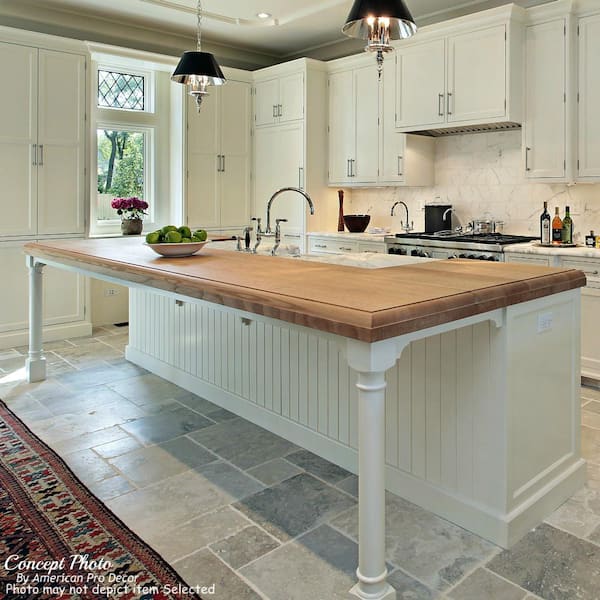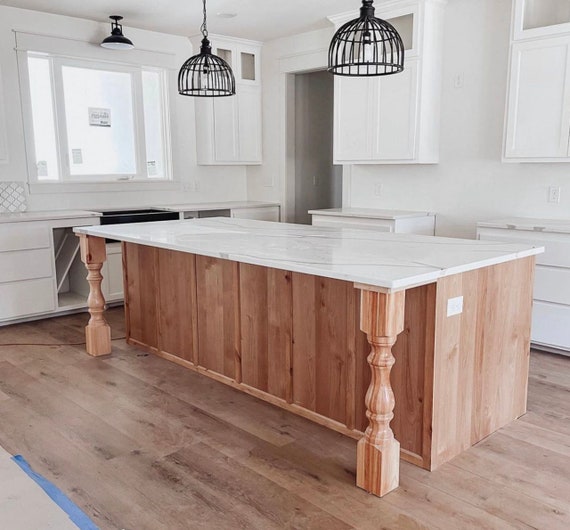Upgrade Your Kitchen with Classy Kitchen Island Leg Solutions
Wiki Article
Exploring the Necessary Attributes of a Cooking Area Island Leg for Your Culinary Space
The cooking area island acts as a main hub in any type of cooking area, and the choice of leg layout is crucial in improving both its capability and aesthetic appeal. Comprehending the essential features of kitchen area island legs-- including material alternatives, layout styles, and security variables-- can dramatically affect the overall experience within the cooking area. As we discover these components, we will certainly discover just how thoughtful modification and devices can raise your kitchen island from a simple utility to a striking centerpiece. What particular factors to consider should be prioritized to accomplish this balance?Importance of Kitchen Island Legs
Cooking area island legs play a crucial function in both the performance and visual appeals of a kitchen area area. They not only support the weight of the island yet likewise enhance the general layout, contributing to the kitchen's aesthetic allure. The selection of legs can dictate the style of the kitchen area, be it contemporary, typical, or rustic.Functionally, durable and appropriately designed legs ensure stability, permitting the safe use the island for numerous jobs such as cooking, eating, or entertaining. Strong legs protect against shifting and wobbling, supplying a reputable surface for daily tasks.
Additionally, the height and placement of the legs can affect the comfort level for those seated at the island. A well-considered height can fit bar stools or chairs, promoting an inviting atmosphere for celebrations.
In addition to these sensible factors to consider, kitchen island legs can function as a centerpiece in the room (kitchen island leg). Decorative or distinctly created legs can boost the layout aesthetic, making the island a centerpiece. Therefore, picking the appropriate kitchen area island legs is vital for stabilizing kind and function in any kind of culinary room
Material Options for Legs
Selecting the appropriate material for cooking area island legs dramatically affects both resilience and layout. Usual material options consist of timber, metal, and rock, each offering distinctive benefits.Wood is a popular choice as a result of its heat and versatility. It can be conveniently tailored to match numerous decoration styles, from rustic to modern. Woods like oak and maple provide exceptional stamina and durability, while softer timbers can be much more prone to put on and tear.
Steel legs are favored for their smooth, modern visual. kitchen island leg. Stainless-steel and light weight aluminum are not only durable yet likewise immune to corrosion and deterioration, making them suitable for cooking area settings. They can produce an industrial appearance and are commonly readily available in various coatings to match other kitchen area elements
Rock legs, such as granite or marble, add an element of luxury and security. While heavier than other products, they provide outstanding toughness and can stand up to considerable weight. They might need extra support to ensure proper equilibrium.
Inevitably, the selection of material need to align with both practical requirements and the general style vision of the kitchen area room, guaranteeing that the island legs enhance both energy and aesthetic appeals.
Layout Styles to Take Into Consideration
What design styles should be thought about when selecting legs for a kitchen area island? The option of leg design dramatically influences the overall visual of your culinary space. For a modern kitchen area, minimalistic and streamlined leg layouts, such as stainless-steel or geometric shapes, can enhance the modern charm, giving a tidy and minimalist appearance.On the other hand, traditional kitchen areas take advantage of timeless designs such as transformed or carved wooden legs, which include warmth and character. These alternatives frequently feature elaborate details that complement vintage home furnishings. For a rustic setting, think about legs made from reclaimed wood or wrought iron, which bring a natural, natural top quality to the space.
If you lean in the direction of an industrial style, robust steel legs view it with a distressed surface may be suitable, supplying an edgy yet advanced touch. Furthermore, farmhouse style cooking areas can integrate chunky legs that stimulate a feeling of toughness and homeliness.

Elevation and Security Variables
The elevation and stability of a kitchen island are crucial elements that straight impact its performance and user experience. An ideal kitchen island leg should offer enough height to fit a variety of jobs, from food preparation to casual eating. Typically, kitchen islands stand between 36 to 42 inches high, aligning with conventional counter and bar elevations. This range ensures comfort for individuals while performing different tasks, hence improving the total functionality of the room.Stability is equally essential, particularly as cooking area islands often function as focal factors in cooking settings. A secure leg layout minimizes wobbling and shifting, which can cause accidents or pain throughout usage. Materials such as strong timber, steel, or a combination thereof are typically employed to attain the required sturdiness. The leg's accessory to the island's base need to be safe and secure, making certain durability and durability against the wear and tear of everyday usage.
Modification and Accessories
Modification choices and accessories for kitchen island legs can see dramatically boost both the visual charm and capability of the area. House owners can select from a range of products, consisting of wood, stone, and metal, enabling seamless assimilation with existing kitchen area design. The selection of coating-- be it a natural discolor, repaint, or powder finish-- further customizes the appearance, making certain that the island complements the total layout style.Along with product and coating, homeowners might also discover the consolidation of accessories such as decorative braces, adjustable feet, or integrated shelving. Brackets can offer added assistance while adding to a rustic or contemporary aesthetic. Flexible feet are specifically valuable for irregular floor covering, making certain the island remains steady and degree, which is essential for both security and usability.

Final Thought
In conclusion, kitchen island legs offer a critical duty in offering stability and improving the general aesthetic of the cooking room. Personalization choices and devices can elevate the cooking area island, making it a distinctive focal factor within the home.The cooking area island serves as a main center in any type of cooking area, and the selection of leg style is investigate this site critical in boosting both its capability and aesthetic allure. Understanding the vital features of kitchen area island legs-- consisting of product choices, design styles, and security factors-- can significantly impact the total experience within the cooking area.Kitchen area island legs play an important duty in both the performance and visual appeals of a cooking area area.What layout styles should be thought about when selecting legs for a kitchen island?In conclusion, kitchen island legs offer a critical duty in supplying stability and enhancing the overall visual of the culinary room.
Report this wiki page